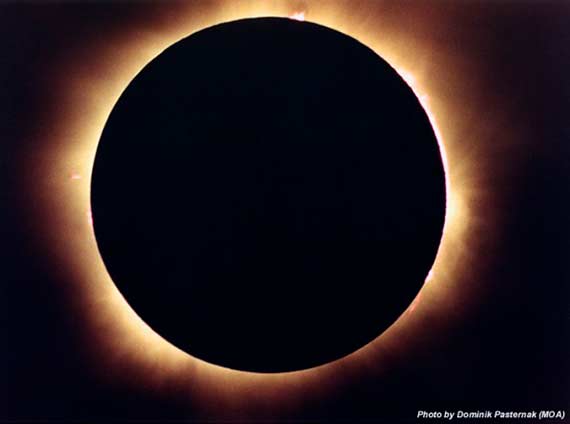On August 21 the Moon will completely erase the Sun from the sky for about two minutes and 40 seconds. That total solar eclipse will be visible in some areas of Greenland, Central America, South America, Western Europe, Northwest Africa, and Eastern Russia, but it is already known as the Great American Eclipse for one reason—it will cross the United States from coast to coast, in a strip about 110 kilometres wide.
It is already considered as the most important total solar eclipse of the century, since the last that was visible in such a large populated area occurred in 1818. “The ‘rarity’ is that solar eclipses are only visible in a narrow strip, the path of the shadow cone of the Moon projecting onto the earth’s surface. A total solar eclipse occurs somewhere on Earth every 18 months, but usually occurs over water -covering 70% of the planet’s surface- or over unpopulated areas,” explains Emilio Gálvez, an astronomer at the Planetarium of Madrid.
The last total eclipse of the Sun, in March 2016, crossed parts of Indonesia, but mostly it was visible from the waters of the Pacific Ocean. The last total continental eclipse in the United States in 1979 was only visible along a small stretch in its passage through the Pacific Northwest. In contrast, the entire path of the eclipse of August 2017 begins in the state of Oregon and ends in South Carolina, passing over several cities across 12 states.

To witness an eclipse like that is literally a unique life experience. In 1926 American astronomers Henry Norris Russell, Raymond Smith Dungan and John Quincy Stewart published the textbook Astronomy, with calculations demonstrating that a total solar eclipse occurs at a given point on the planet only once every 360 years. Most recently, the Belgian astronomer Jean Meeus recalculated that figure statistically in an HP-85 microcomputer and found that the average frequency for a total eclipse of the sun for any given point in the surface of the Earth is once every 375 years.
In general, a solar eclipse occurs when the Moon passes completely in front of the Sun, casting a shadow over part of the Earth. To see a total eclipse, you have to be in the darkest part of this shadow, the umbra. When you are in the lighter part of the shadow, the penumbra, what you see is a partial eclipse. In other words, this phenomenon only occurs when the Moon is very well aligned between our planet and the Sun. Since the satellite takes about 30 days to complete a revolution around the Earth, solar eclipses could theoretically occur once a month, but the lunar orbit is inclined (relative to that of the Earth around the Sun), so that the lunar disk and the solar disk do not always intersect.
Visualizing the 2017 All-American Eclipse. Credit: NASA’s Goddard Space Flight Center
There is also a bit of cosmic serendipity at play, the Sun is about 400 times larger than the Moon, but it is also 400 times farther from the planet, which makes the two disks appear to be the same size in the sky. In addition, the path of the Moon’s orbit is not a perfect circle, but forms an ellipse, so the distance between the Moon and Earth is not constant over time, but is subject to small variations. When our satellite is further away from the planet, its size is not large enough to completely cover the Sun and an annular eclipse occurs, which results in a “ring of fire” that surrounds the lunar disk.

But it has not always been like that, nor will be in the far future. Paleontological studies have calculated that, billions of years ago, the Moon was much closer to Earth and therefore larger than the Sun and that total solar eclipses were more frequent. Astronomer Edmond Halley discovered in the eighteenth century that, as the Moon raises the tides in the ocean, the rotation of the Earth gradually diminishes, transferring the angular momentum of rotation to the Moon’s orbit, which, in turn, is constantly moving away from the planet. Therefore, in the very distant future, our natural satellite will be far enough away not to completely cover the Sun, and from that moment on no more total solar eclipses will ever be seen from Earth.
Opportunity for science
In addition to being a spectacle for human eyes, an eclipse like that of August 2017 is special from a scientific point of view. “The phenomenon will cross large terrestrial masses uninterrupted, which will allow us to maximize data collection and connect the shadow of the Moon with Earth science,” says Madhulika Guhathakurta, NASA’s astrophysicist. The North American Space Agency has 11 projects that you can explore thanks to the eclipse, including the variable luminosity of the Sun and the relationship between surface temperatures and atmospheric changes.
“It is also an opportunity to study the solar corona [the outermost layer of the Sun, composed of plasma],” adds Alberto Brum, supervisor of the Astronomy Program at the Federal University of Bahia in Brazil. “When the solar disk is completely blocked by the Moon, you can observe the atmosphere of the star and its protuberances. The analysis of these elements is important to understand, for example, solar storms and their consequences on our planet,” he explains.
Comments on this publication